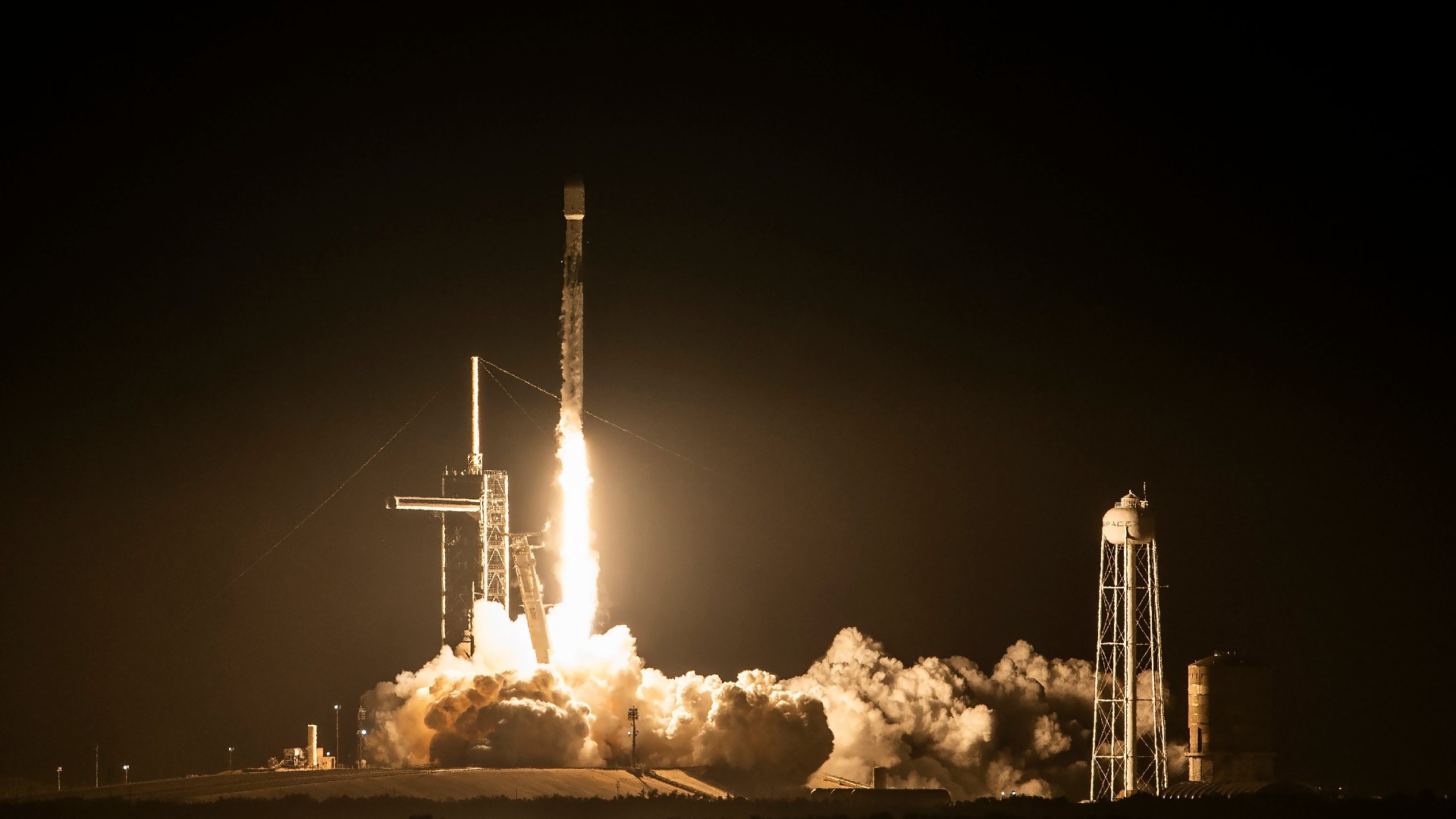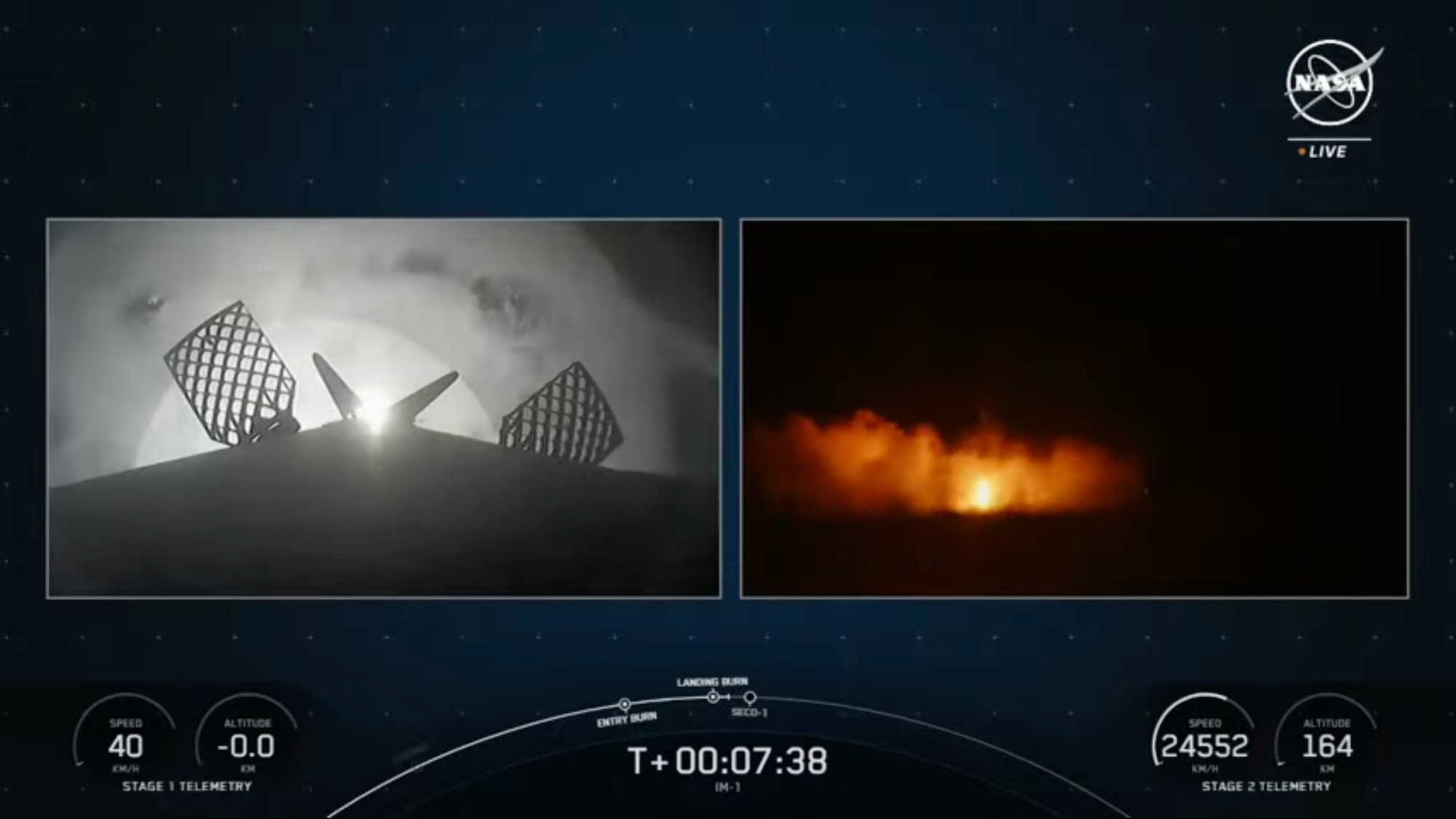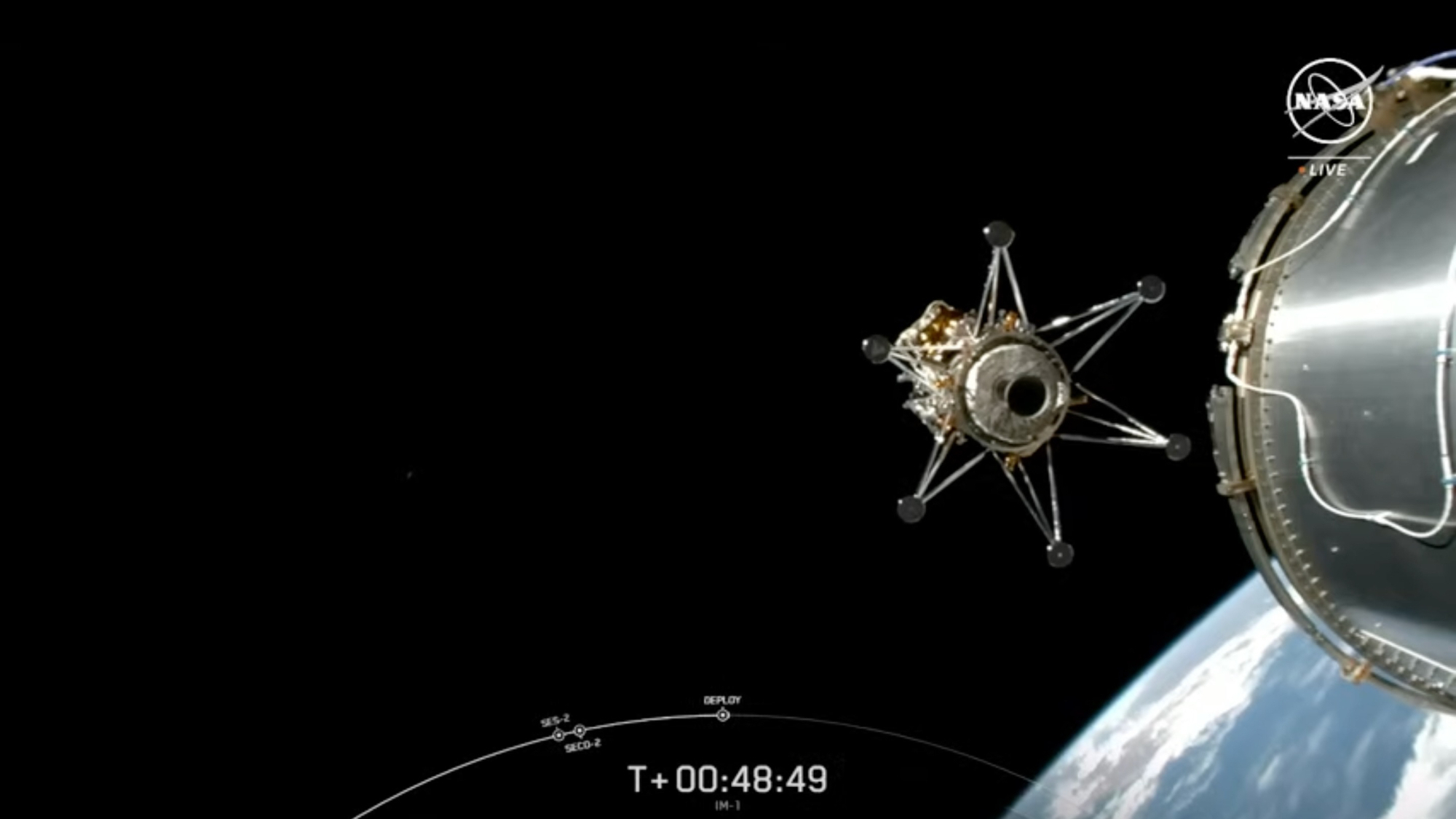
A potentially history-making private moon mission is underway.
Odysseus, a robotic lunar lander built by the Houston-based company Intuitive Machines, lifted off atop a SpaceX Falcon 9 rocket from NASA's Kennedy Space Center (KSC) in Florida early this morning (Feb. 15).
If all goes according to plan, Odysseus will touch down near the moon's south pole on Feb. 22, becoming the first-ever private spacecraft to ace a lunar landing. Success would also be a big deal for the United States, which hasn't been to the lunar surface since NASA's Apollo 17 mission more than half a century ago.
"It is a profoundly humbling moment for all of us at Intuitive Machines," Trent Martin, the company's vice president of space systems, said during a prelaunch press conference on Tuesday (Feb. 13).
"The opportunity to return the United States to the moon for the first time since 1972 demands a hunger to explore, and that's at the heart of everyone at Intuitive Machines," he added.
Related: Moon mining gains momentum as private companies plan for a lunar economy

A smooth launch (and rocket landing)
The Falcon 9 lifted off from KSC's Pad 39A today at 1:05 a.m. EST (0605 GMT). About 7.5 minutes later, the rocket's first stage came back to Earth for a vertical touchdown at Cape Canaveral Space Force Station, which is next door to the NASA site.
It was the 18th launch and landing for this particular booster, according to a SpaceX mission description. That's just one short of the company's reuse record, which it set this past December.

The Falcon 9's upper stage, meanwhile, kept powering its way into the sky, eventually deploying Odysseus into a lunar transfer orbit roughly 48.5 minutes after launch as planned.
The 1,490-pound (675-kilogram) lander — which is about the size of a British telephone booth (or the TARDIS craft in "Dr. Who," if you're a sci-fi fan) — made its first contact with mission control a few minutes later.
Odysseus will soon start making its way toward lunar orbit, a journey that will take six days. Odysseus will then gear up for its historic landing attempt, which will take place at Malapert A, a small crater about 190 miles (300 kilometers) from the moon's south pole.
NASA will watch the touchdown try with especially keen interest, for the space agency has a lot riding on Odysseus and its current mission, known as IM-1.

Paving the way for Artemis astronaut moon missions
NASA booked a ride on IM-1 via its Commercial Lunar Payload Services (CLPS) program, which seeks to leverage the capabilities of private American robotic landers to get agency science gear down on the moon more cost-effectively.
These instruments are designed to collect data that will aid NASA's Artemis program, which aims to establish a crewed base near the moon's south pole by the end of the 2020s. This region is thought to be rich in water ice, which could support Artemis astronauts on the surface and also be processed into rocket propellant, allowing crews to refuel spacecraft away from Earth.
Odysseus is carrying six NASA instruments on IM-1, which were put on board via a NASA contract valued at $118 million. It cost the agency an additional $11 million to develop and build the scientific hardware, NASA officials have said.
Here's a brief rundown of those NASA science instruments:
- ROLSES (Radio Observations of the Lunar Surface Photoelectron Sheath) will characterize the electron plasma and radio environments near IM-1's landing site;
- LRA (Laser Retro-Reflector Array), a tiny set of reflectors, will serve as a guidepost to help future landers make precision touchdowns on the moon;
- NDL (Navigation Doppler Lidar for Precise Velocity and Range Sensing) will use LIDAR (light detection and ranging) technology to gather super-precise data during Odysseus' descent and landing;
- SCALPSS (Stereo Cameras for Lunar Plume-Surface Studies) will study how Odysseus' exhaust plume interacts with lunar dirt and rocks during landing, gathering data that could inform future Artemis lander designs;
- LN-1 (Lunar Node 1 Navigation Demonstrator), a small radio navigation beacon, will demonstrate autonomous spacecraft positioning tech, which could aid future lunar rovers and landers and eventually become part of a larger, GPS-like system on and around the moon;
- RFMG (Radio Frequency Mass Gauge statement) will use radio waves to measure how much fuel is left in Odysseus' tank — something that's tough to do in a microgravity environment.
Odysseus is also carrying six commercial payloads for a variety of customers, including Columbia Sportswear, which will test its "Omni-Heat Infinity" insulative material on IM-1.
Among the other private payloads is a set of sculptures by artist Jeff Koons and a "secure lunar repository," which aims to help safeguard the entirety of human knowledge should something terrible happen here on Earth.
Also flying on IM-1 is EagleCam, which was built by students at Embry-Riddle Aeronautical University. This camera system will deploy from Odysseus as it nears the lunar surface and attempt to snap photos of the lander's touchdown.
You can learn more about all of the IM-1 payloads via Intuitive Machines' press kit, which you can find here.
Related: Missions to the moon: Past, present and future
A 2nd try at a lunar 1st
IM-1 isn't the first CLPS effort to launch toward the moon. Astrobotic's Peregrine lander did so on Jan. 8, lifting off on the debut mission of United Launch Alliance's new Vulcan Centaur rocket.
That launch went well, but Peregrine suffered a crippling fuel leak shortly after deploying from the rocket's upper stage. After quite a long saga, the lunar lander ended up making a controlled destruction in Earth's atmosphere on Jan. 18.
As Peregrine's example shows, acing a moon mission remains a tall order — especially for a private spacecraft. So, there's certainly no guarantee that Odysseus will succeed, especially this early in the game. NASA has tapped Intuitive Machines for two additional moon missions after this one, and the agency plans to put payloads on future commercial landers as well.
"We've always viewed these initial CLPS deliveries as being kind of a learning experience, where we're all going to learn and react to how they go," Joel Kearns, deputy associate administrator for Exploration, Science Mission Directorate at NASA headquarters, said during Tuesday's prelaunch telecon.
"We're learning from every attempt — not only that we have in the U.S., but we also watch the attempts being made by some of our allies, and some of our competitors," he added.
Editor's note: This story was updated at 2:15 a.m. ET on Feb. 15 with news of successful spacecraft deployment.






